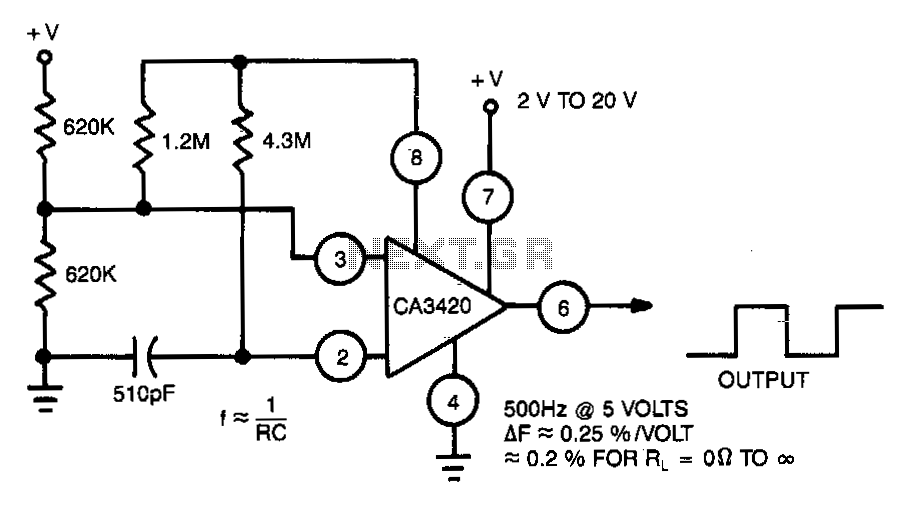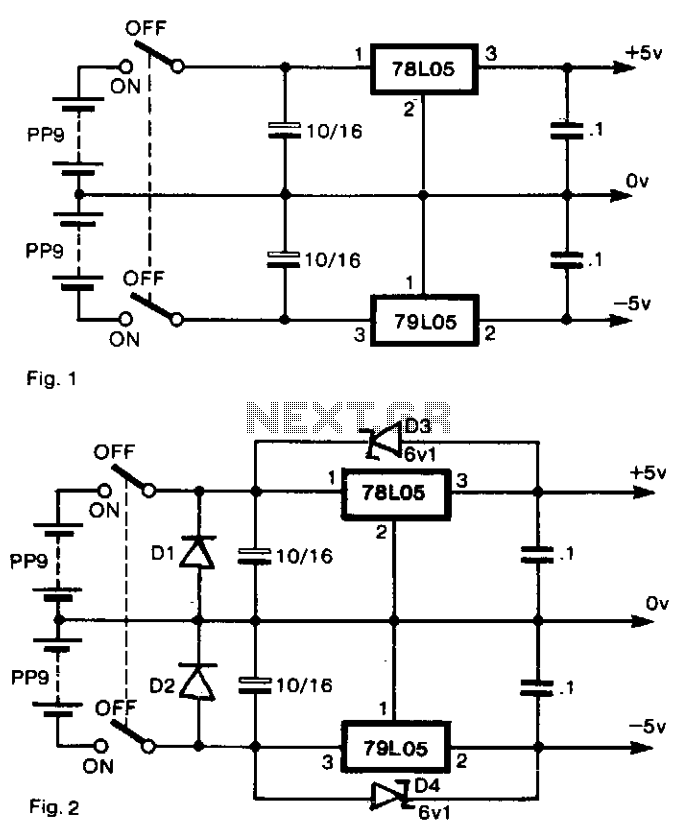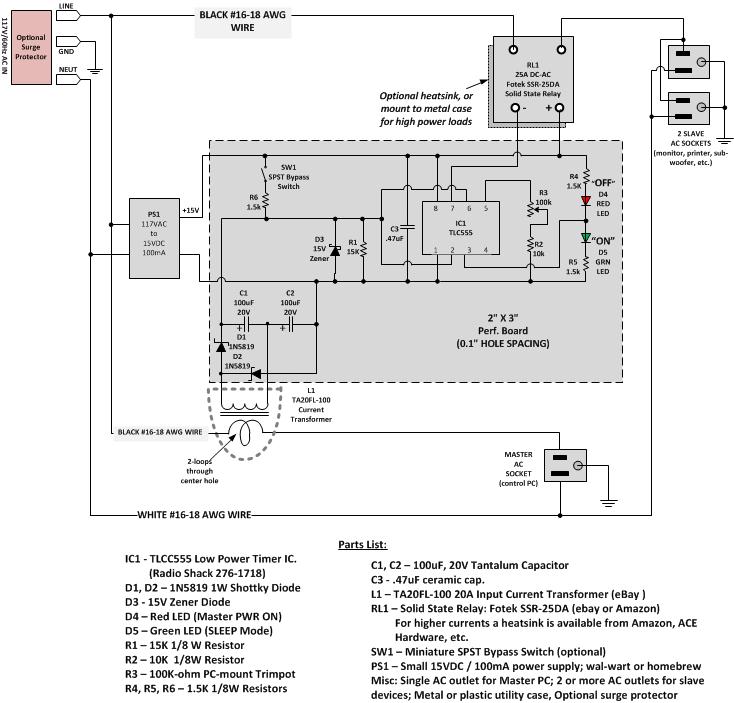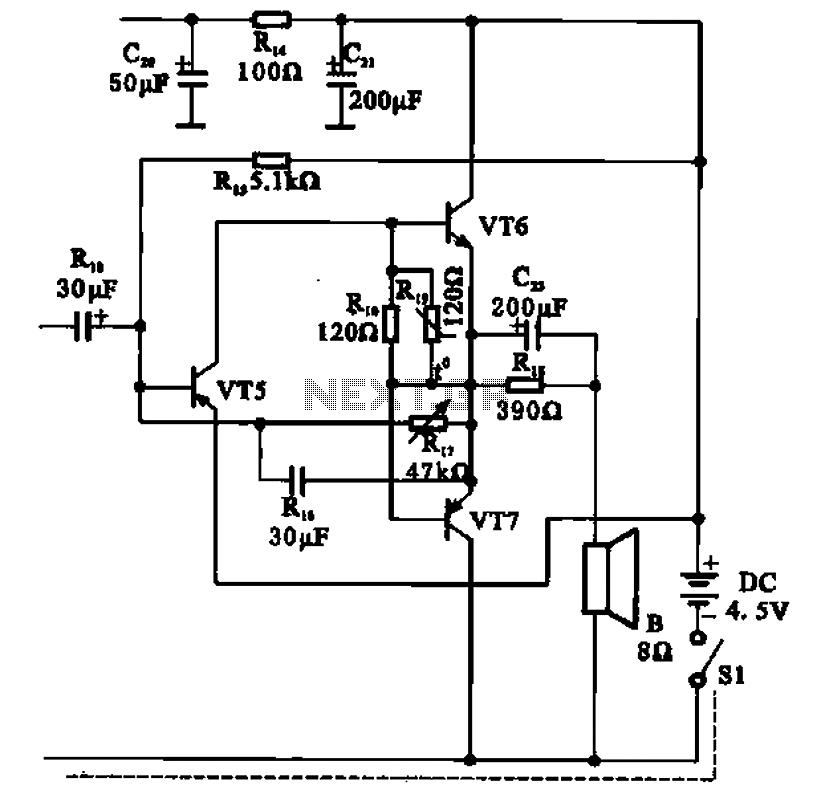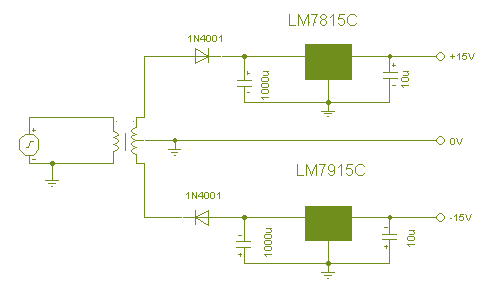
Alternative Halogen Power Supply
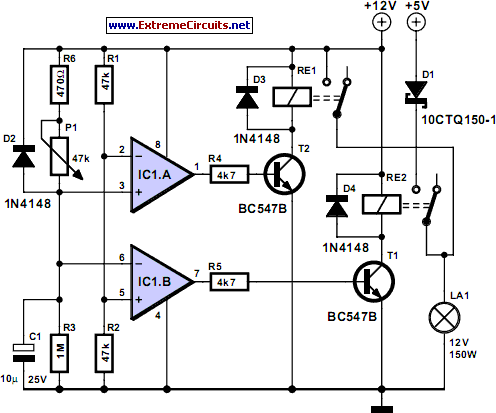
Readers who do not wish to modify the power supply of an old PC into a suitable halogen power source may find the current design a welcome alternative. The circuit does not require any alterations to the power supply. It allows halogen lamps to be initially powered from the 5V rail of the supply via RE2, so they can be reheated. Subsequently, they are powered from the 12V rail via RE1, while the 5V rail is disconnected. This ensures that the current surge through the lamps is minimal, preventing the power supply's protection from triggering. The operation of the circuit is as follows: as soon as the PC supply provides power, IC1.B drives T1 into conduction and RE2 closes. The potential at the non-inverting input of IC1.B is 6V, while the inverting input rises from 0V. Lamp LA1 is then connected to the 5V rail. After a short duration, the voltage across C1 rises to a point where IC1.B switches, cutting off T1. Simultaneously, IC1.A drives T2 into conduction. The circuit is then decoupled from the 5V rail and connected to the 12V terminal. The 5V rail in the PC power supply is protected against spikes on the 12V line by D1. Diode D2 safeguards IC1 against over-voltage on its inputs in the event of a 12V rail failure. Resistors R4 and R5 limit the base currents of the transistors. D3 and D4 serve as quenching diodes. The duration during which lamp LA1 is powered by 5V is preset with potentiometer P1. The maximum time span is approximately 0.33 seconds, and the minimum is 3.3 milliseconds. The latter may be relatively short, but it also depends on the type of power supply used, warranting some experimentation.
The described circuit provides a practical solution for powering halogen lamps using an existing PC power supply without the need for modifications. This design leverages the 5V and 12V rails of the power supply, ensuring a smooth transition from initial heating to stable operation. The use of two operational amplifiers (IC1.A and IC1.B) plays a critical role in controlling the timing and switching of the transistors (T1 and T2), which manage the power delivery to the halogen lamp (LA1).
The initial connection to the 5V rail allows for a quick warm-up period, while the subsequent switch to the 12V rail ensures that the halogen lamp operates efficiently without drawing excessive current that could trip the power supply's protection mechanisms. The inclusion of diodes (D1 and D2) provides necessary protection against voltage spikes and over-voltage conditions, enhancing the reliability of the circuit.
Resistors R4 and R5 are essential for controlling the base current to the transistors, allowing for stable operation and preventing potential damage to the components. The quenching diodes (D3 and D4) further protect the circuit from back EMF generated by the inductive loads when the transistors switch off.
The adjustable timing feature provided by potentiometer P1 offers flexibility in the warm-up time of the lamp, accommodating various types of power supplies and user preferences. This adaptability is beneficial for achieving optimal performance across different setups, making the circuit a versatile choice for users looking to utilize halogen lamps in conjunction with standard PC power supplies. Overall, this design exemplifies efficient engineering practices in circuit design, ensuring functionality, safety, and user customization.Readers who do not care to modify the power supply of an old PC into a suitable halogen power source (see our April 2006 issue), may find the present design a welcome alternative. The circuit does not need any changes to the power supply. It allows the halogen lamps to be initially powered from the 5V rail of the supply via RE2, so that they are p
reheated. Subsequently, they are powered from the 12-V rail via RE1, while at the same time the 5-V rail is disconnected. This ensures that the current surge through the lamps is so small that the protection in the power supply does not react.
Operation of the circuit is as follows. As soon as the PC supply provides power, IC1. B drives T1 into conduction and RE2 closes. The potential at the non-inverting input of IC1. B is 6 V, while that at the inverting input rises from 0 V. Lamp LA1 is then connected to the 5-V rail. After a short span of time, the voltage across C1 has risen to a value where IC1. B changes over, whereupon T1 is cut off. At the same time, IC1. A drives T2 into conduction. The circuit is then decoupled from the 5-V rail and connected to the 12-V terminal. The 5-V rail in the PC power supply is protected against spikes on the 12-V line by D1. Diode D2 protects IC1 against over-voltage on its inputs should the 12-V rail fail. Resistors R4 and R5 limit the base currents of the transistors. D3 and D4 are quenching diodes. The time during which lamp LA1 is powered by 5 V is preset with potentiometer P1. The maximum time span is about 0. 33 s and the minimum 3. 3 ms. The latter is perhaps rather short, but it also depends to some extent on the type of power supply used. Some experimentation may be worthwhile! 🔗 External reference
The described circuit provides a practical solution for powering halogen lamps using an existing PC power supply without the need for modifications. This design leverages the 5V and 12V rails of the power supply, ensuring a smooth transition from initial heating to stable operation. The use of two operational amplifiers (IC1.A and IC1.B) plays a critical role in controlling the timing and switching of the transistors (T1 and T2), which manage the power delivery to the halogen lamp (LA1).
The initial connection to the 5V rail allows for a quick warm-up period, while the subsequent switch to the 12V rail ensures that the halogen lamp operates efficiently without drawing excessive current that could trip the power supply's protection mechanisms. The inclusion of diodes (D1 and D2) provides necessary protection against voltage spikes and over-voltage conditions, enhancing the reliability of the circuit.
Resistors R4 and R5 are essential for controlling the base current to the transistors, allowing for stable operation and preventing potential damage to the components. The quenching diodes (D3 and D4) further protect the circuit from back EMF generated by the inductive loads when the transistors switch off.
The adjustable timing feature provided by potentiometer P1 offers flexibility in the warm-up time of the lamp, accommodating various types of power supplies and user preferences. This adaptability is beneficial for achieving optimal performance across different setups, making the circuit a versatile choice for users looking to utilize halogen lamps in conjunction with standard PC power supplies. Overall, this design exemplifies efficient engineering practices in circuit design, ensuring functionality, safety, and user customization.Readers who do not care to modify the power supply of an old PC into a suitable halogen power source (see our April 2006 issue), may find the present design a welcome alternative. The circuit does not need any changes to the power supply. It allows the halogen lamps to be initially powered from the 5V rail of the supply via RE2, so that they are p
reheated. Subsequently, they are powered from the 12-V rail via RE1, while at the same time the 5-V rail is disconnected. This ensures that the current surge through the lamps is so small that the protection in the power supply does not react.
Operation of the circuit is as follows. As soon as the PC supply provides power, IC1. B drives T1 into conduction and RE2 closes. The potential at the non-inverting input of IC1. B is 6 V, while that at the inverting input rises from 0 V. Lamp LA1 is then connected to the 5-V rail. After a short span of time, the voltage across C1 has risen to a value where IC1. B changes over, whereupon T1 is cut off. At the same time, IC1. A drives T2 into conduction. The circuit is then decoupled from the 5-V rail and connected to the 12-V terminal. The 5-V rail in the PC power supply is protected against spikes on the 12-V line by D1. Diode D2 protects IC1 against over-voltage on its inputs should the 12-V rail fail. Resistors R4 and R5 limit the base currents of the transistors. D3 and D4 are quenching diodes. The time during which lamp LA1 is powered by 5 V is preset with potentiometer P1. The maximum time span is about 0. 33 s and the minimum 3. 3 ms. The latter is perhaps rather short, but it also depends to some extent on the type of power supply used. Some experimentation may be worthwhile! 🔗 External reference
